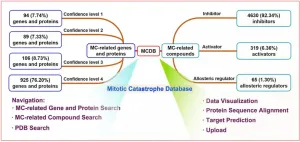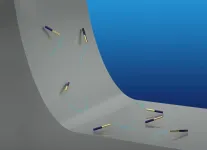Heisenberg under the microscope
2021-07-14
(Press-News.org) A football is not a quantum particle. There are crucial differences between the things we know from everyday life and tiny quantum objects. Quantum phenomena are usually very fragile. To study them, one normally uses only a small number of particles, well shielded from the environment, at the lowest possible temperatures.
Through a collaboration between the University of Vienna, the Austrian Academy of Sciences and TU Wien, however, it has now been possible to measure a hot glass sphere consisting of about one billion atoms with unprecedented precision and to control it at the quantum level. Its movement was deliberately slowed down until it assumed the ground state of lowest possible energy. The measurement method almost reached the limit set by Heisenberg's uncertainty principle - physics just does not allow for any more precision than that. This was made possible by applying special methods from control engineering to quantum systems. The results have now been published in the scientific journal "Nature".
Perfect precision is impossible
The measurement influences the measured object - this is one of the most basic principles of quantum theory. "Werner Heisenberg came up with a famous thought experiment - the so-called Heisenberg microscope" explains physicist Lorenzo Magrini, the first author of the study from the University of Vienna. "If you want to measure the position of an object very precisely under a microscope, you have to use light with the shortest possible wavelength. But short wavelength means higher energy, so the movement of the particle is disturbed more strongly." You just cannot accurately measure the location and the state of motion of a particle at the same time. The product of their uncertainties is always limited by Planck's constant - this is the so-called Heisenberg uncertainty principle. However, it is possible to find out how close one can get to this limit set by nature.
Prof. Markus Aspelmeyer's team at the University of Vienna is investigating this using a glass sphere with a diameter of less than 200 nanometres, consisting of about one billion particles - very small by our everyday standards, but still very large compared to objects usually studied in quantum physics.
The glass sphere can be kept in place with a laser beam. The atoms of the sphere are heated up by the laser, and the internal temperature of the sphere rises to several hundred degrees Celsius. This means that the atoms of the glass sphere are wobbling around violently. In the experiment, however, it was not the wobbling movements of the individual atoms that were studied, but the collective motion of the sphere in the laser trap. "These are two completely different things, just as the movement of a pendulum in a pendulum clock is something different from the movement of the individual atoms inside the pendulum," says Markus Aspelmeyer.
Quantum control technology
The goal was to precisely control the pendulum motion of the glass sphere on a quantum level, even though the glass sphere is actually a macroscopic object. This can only be achieved using a perfectly designed control system, carefully adjusted to the experiment. This task was taken on by the team of Prof. Andreas Kugi at TU Wien.
"Control engineering is about influencing systems in such a way that they exhibit a desired behaviour independent of disturbances and parameter fluctuations," says Andreas Kugi. "This can be a robot arm, for example, a production line in a factory, or even the temperature of a blast furnace." Applying modern methods of control engineering to quantum systems opens up new possibilities. "However, one also has to face challenges that do not exist in classical system theory and control engineering," explains Kugi. "In classical control engineering, the measurement has no or negligible influence on the system. In quantum physics, however, this influence cannot be avoided, for very fundamental reasons. We therefore also have to develop novel control engineering methods."
This was a success: the light backscattered by the glass sphere was detected as thoroughly as possible, using a sophisticated microscopy technique. By analyzing the scattered light, the position of the sphere was determined in real time, and then an electric field was continuously adjusted in such a way that it permanently counteracted the movement of the glass sphere. In this way, it was possible to slow down the entire sphere and put it into a state of motion that corresponds to the quantum-physical ground state, i.e. the state of the smallest possible kinetic energy - despite the fact that it is a relatively large object at high temperatures, whose atoms wobble vigorously.
Promising cooperation between physics and control engineering
"You always have to consider spatial and kinetic uncertainty together. Overall, the quantum uncertainty of the glass sphere was only 1.7 times Planck's quantum of action," says Lorenzo Magrini. Planck's constant would be the absolute theoretical lower limit, never before has an experiment come that close to the absolute quantum limit using an object of this size. The kinetic energy measured in the experiment corresponded to a temperature of just 5 micro-Kelvin, i.e. 5 millionths of a degree above absolute zero. The movement of the glass sphere as a whole can therefore be assigned an extremely low temperature even if the atoms that make up the sphere are very hot.
This success shows the great potential of this new combination of quantum physics and control engineering: both research groups want to continue working in this direction and exploit know-how from control engineering to enable even better and more precisely controlled quantum experiments. There are many possible applications for this, ranging from quantum sensors to technologies from the field of quantum information.
INFORMATION:
Publication in Nature:
Real-time optimal quantum control of mechanical motion at room temperature
Lorenzo Magrini, Philipp Rosenzweig, Constanze Bach, Andreas Deutschmann-Olek, Sebastian G. Hofer, Sungkun Hong, Nikolai Kiesel, Andreas Kugi and Markus Aspelmeyer.
DOI: 10.1038/s41586-021-03602-3
[Attachments] See images for this press release:

ELSE PRESS RELEASES FROM THIS DATE:
2021-07-14
Mitotic Catastrophe Database (MCDB) is a proprietary, standard, and comprehensive database for Mitotic catastrophe (MC) related data facilitating the exploration of MC for all researchers in the fields of medicinal chemistry, molecular biology, bioinformatics and oncology.
MC is a form of programmed cell death induced by mitotic process disorders, which is important in tumor prevention, development, and drug resistance. As availability of MC data underpins tumor-related biomedical and clinical studies, the development of a professional and comprehensive database to curate MC-related data is a matter of increasing priority.
MCDB consists of 1214 genes/proteins and 5014 compounds ...
2021-07-14
Jacksonville, Fla. - A recent qualitative research study conducted by the University of North Florida, in partnership with Indianan University-Purdue Indianapolis and UF Health Jacksonville, shows that black teenage girls want inclusive body types to be featured in advertising to combat teen obesity rates. Insights provided in the study are ideal for pediatricians and healthcare educators developing advertising and patient care plans to combat obesity among African American teens.
The study investigated social and cultural consequences of food consumption among African American teenage girls between the ages of 14-18 in Jacksonville, Fla., and explored best practices ...
2021-07-14
A team of scientists has uncovered how heavy, motorized objects climb steep slopes--a newly discovered mechanism that also mimics how rock climbers navigate inclines.
The findings, which appear in the journal Soft Matter, stem from a series of experiments in which motorized objects were placed in liquid and then moved up tilted surfaces.
"These 'micro-swimmers' are about 20 times heavier than the fluid they swim in, but they were able to climb steep slopes that are almost vertical," explains Jun Zhang, one of the paper's authors and a professor of physics and mathematics at New York University's Courant Institute of Mathematical Sciences and NYU Shanghai.
The work enhances our understanding of "gravitaxis"--directional ...
2021-07-14
The physical interactions between coral and algal cells as they combine to form a symbiotic relationship have been observed for the first time. Within minutes of being introduced, coral cells had started to engulf the algae, where they were either digested or moved to a protective 'bubble' within the cell. This new study, published in Frontiers in Marine Science, will form the basis of further research to understand what drives their symbiosis at a cellular and molecular level, including the eviction of algae, which is the cause of coral bleaching.
"We watched coral cells develop pseudopodia ...
2021-07-14
Depression is the most frequently diagnosed psychiatric disorder among older adults, with 8% to 16% of older patients presenting with clinically significant depressive symptoms. Researchers in Spain conducted a randomized clinical trial of 347 older adults with mild to moderate depression, comparing the effectiveness of physical exercise and antidepressants as treatment methods. Study participants were assigned to either a group engaged in supervised physical exercise or a group that received antidepressant treatment by their general practitioners. Depressive symptoms were not significantly different after one month between the two groups. However, after three and six months, the number of people who showed improvement was significantly higher in the ...
2021-07-14
WASHINGTON--People with diabetes and depression who take antidepressants may have a lower risk of death and of serious diabetes complications, according to a new study published in the Endocrine Society's Journal of Clinical Endocrinology & Metabolism.
People with diabetes face a higher risk of depression, which makes them more likely to die or develop diabetes complications including heart and kidney disease, stroke, eye, and foot problems. Depression makes diabetes complications worse due to stress, body weight changes, and lack of exercise.
"People with depression and diabetes have poorer health outcomes than those with diabetes alone, and regular antidepressant treatment could lower their risk of complications," said study author Shi-Heng Wang, Ph.D., of the China Medical ...
2021-07-14
Researchers at Johns Hopkins Bloomberg School of Public Health have shown in a brain organoid study that exposure to a common pesticide synergizes with a frequent autism-linked gene mutation.
The results represent one of the clearest pieces of evidence yet that genetic and environmental factors may be able to combine to disturb neurodevelopment. Researchers suspect that genetic and environmental factors might contribute to the increased prevalence of autism spectrum disorder, a developmental disorder characterized by cognitive function, social, and communication impairments.
The study's use of brain organoids also points the way towards quicker, less expensive, and more human-relevant ...
2021-07-14
Forest fires are already a global threat. "But considering how climate change is progressing, we are probably only at the beginning of a future that will see more and bigger forest fires," explains Rupert Seidl, Professor of Ecosystem Dynamics and Forest Management in Mountain Landscapes at TUM.
In many places, fire is part of the natural environment, and many tree species have become naturally adapted to recurrent fires. These adaptations range from particularly thick bark, which protects the sensitive cambium in the trunk from the fire, to the cones of certain types of pine, which open only due to the heat of fire, allowing a quick regeneration and recovery of affected woodland .
AI is accelerating ecosystem models
"The interaction ...
2021-07-14
Skoltech researchers and their colleagues from the U.S. and Singapore have created a neural network that can help tweak semiconductor crystals in a controlled fashion to achieve superior properties for electronics. This enables a new direction of development of next-generation chips and solar cells by exploiting a controllable deformation that may change the properties of a material on the fly. The paper was published in the journal npj Computational Materials.
Materials at the nanoscale can withstand major deformation. In what's called the strained state, they can exhibit remarkable optical, thermal, electronic, and other properties due to a change in interatomic distances. The intrinsic properties of a strained ...
2021-07-14
Researchers examined the role of primary care physicians and other clinicians in delivering vaccinations in the United States. They used two main datasets to create an in-depth analysis of services delivered to Medicare patients, followed by analysis of the Agency for Healthcare Research and Quality's 2017 Medical Expenditure Panel Survey (MEPS) to determine where patients are getting vaccinated and by whom. In the 2017 Medicare Part B Fee-For-Service, primary care physicians provided the largest share of services for vaccinations (46%), followed by mass immunizers (45%), then nurse practitioners/physician assistants (5%). The MEPS showed that primary care physicians provided a majority of clinical visits ...
LAST 30 PRESS RELEASES:
[Press-News.org] Heisenberg under the microscope



